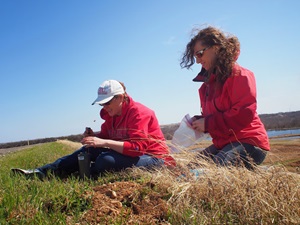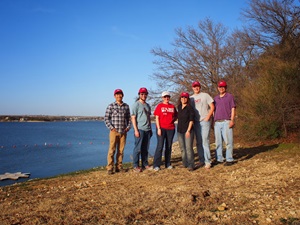Heather DeShon
Returning to the Hilltop to Shape a New Generation of Scientists
Dr. Heather DeShon, Associate Professor in the Roy M. Huffington Department of Earth Sciences, describes how her love of science as a child led her to pursue a career in academia, her return to the Hilltop as a member of the faculty, and how women are making progress in the sciences.
How did you first discover your passion for geophysics?
In elementary school I always chose the earthquake or volcano for class projects and loved to camp and be outdoors with my family, and I remained very interested in all things science throughout junior high and high school. My mother made me read her National Geographic magazine so she could have someone to talk to about the articles, and that experience instilled a fundamental interest and love of learning. I actually have the May 1984 National Geographic displayed in my office with the article on Mt. Vesuvius that I reported on for an elementary grade science project. It was not until I was midway through high school that I realized that all of my favorite hobbies and science topics were, in fact, Earth Science topics, and I could spend my career studying and teaching about earthquakes and volcanoes. I declared a major in Geophysics before I arrived at SMU in 1995, and I never looked back.

Can you tell me about your history with SMU? What first attracted you to SMU as an undergraduate, and then reattracted you back to campus to teach?
I first saw SMU when my mother and grandmother moved me into Cockrell Hall as a freshman. I am from Missouri and had never made it to Dallas to view the school. I applied to four schools with solid geology and/or geophysics programs and good endowment support for merit-based grants and scholarships, because that is what the family budget required! I moved quite a bit as a child so I was not particularly tied to the rural town in Missouri where I finished high school, and I was ready to move to a larger city. SMU provided enough financial aid that I could attend. At the end of my sophomore year, my financial aid package changed, and I was in the process of transferring to Mizzou. I loved SMU, and beginning that transfer process was a hard decision for us. Luckily, I was fortunate to be named a President’s Scholar and receive a Barry Goldwater Research Scholarship, so I could stay and finish my last two years at SMU and complete my undergraduate research experience.
I was a Research Associate Professor at the University of Memphis working primarily with graduate students on research when SMU advertised a tenure-track faculty position in Seismology in 2010/2011. It is not common to return to teach and conduct research at your undergraduate institution. I was well-suited for the position description, however, and had fond memories of Dallas. My experience at SMU was truly life-changing, and I wanted to be in an environment where I could provide mentoring at both the undergraduate and graduate level. I also missed teaching across a broad range of levels; I come from a family of high school level educators. I was excited at the opportunity to return.
What do you think makes SMU’s Earth Sciences Department unique from similar departments at other universities?
The SMU Earth Sciences Department has always emphasized outstanding research and teaching in fundamental research topics of national or educational importance. The Department also favored overlapping faculty interests to build depth within specific subdisciplines (paleo-studies, geochemistry, geophysics) with a more limited number of faculty members. The result of this vision is that SMU Earth Sciences faculty include nationally and internationally recognized scientists working together on important and societally relevant research that can brought into the classroom from our non-majors courses through to our Ph.D. program.
Where do your research interests lie? How does your research impact our local community? How do you foresee your research specifically and/or geophysics research in general evolving in the future?
I am an earthquake seismologist. For many, those two words mean the same thing, but seismology is simply understanding waves travelling through the Earth. The field provides the fundamental tools used for a range of societal issues, such as imaging the subsurface for energy resources, mitigating geohazards (earthquakes, volcanoes, landslides, tsunamis, etc.), and monitoring weapons testing programs. Most recently, my research lab has been conducting research and operating a set of seismometers monitoring earthquakes likely induced by oil and gas operations in the Dallas-Fort Worth metropolitan area. My other research interests focus on improving global real-time earthquake catalogs to better track aftershock sequences of large earthquakes and on using earthquake waves to better define the subsurface velocity structure, to understand process interactions leading to earthquakes on faults and within volcanoes. Earthquakes, volcanoes, and tsunamis will always co-exist with societies, and my research and outreach efforts are aimed at providing insights to mitigate the hazards and better prepare local communities.
What are your thoughts on the position of women in the field of geophysics and/or STEM fields in general? Do you feel the landscape has shifted for women in the field of geophysics from when you first started out to today? What factors do you think have influenced any changes you perceive?
I have been lucky to have female faculty mentors dating to my undergraduate research at SMU. For my mentors, it was less common to have women collaborators and fellow faculty members. This is changing. SMU has four women faculty in Earth Sciences now, and it is not uncommon for the graduate population at many Earth Sciences programs to be equal numbers in terms of gender. I believe that students find science, and the idea of having fulfilling scientific careers, more accessible when the faculty themselves reflect a range of gender and life choices. Like most physical sciences, Earth Sciences has a leaky pipeline problem with the number of women under-represented in the more advanced career stages in academia and industry. There is always progress to be made, and we need to find more effective strategies and institutional structures to allow women to have successful scientific careers over the long-term and not switch mid-career into other fields.
